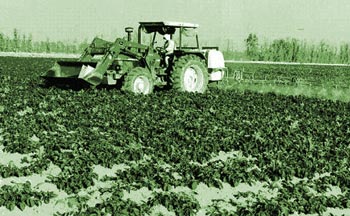Al Kharj: The Agri Capital of Saudi |
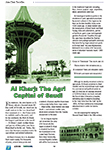 |
<<Click to see original |
For centuries, the area known as Al Kharj, which is located about 80 km south of Riyadh, has stood out. In stark contrast to the vast desertland that surrounds it — the Dahna with its reddish sand to the north, and to the southeast, the Rub Al-Khali, the largest sand desert in the world — Al-Kharj’s small verdant farms and groves of date palm trees have flourished in fertile soil. Today, this oasis has become a modern centre for agriculture and related industries.
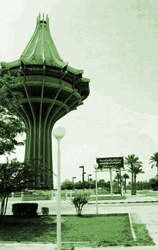
Al-Kharj’s fortunes lie in its abundant fresh water supply. For thousands of years, several deep ponds and a network of natural aquifers have been continuously fed by three major wadis — Wadi Sahba, Wadi Hanifah and Wadi Nisah — and several smaller ones, which drain rainwater from the Tuwaiq escarpment to the west.
For as long as anyone can remember, the area of Al Yamamah (the region in which Al Kharj is situated) has been the food basket of the Lower Najd. Farmers there have historically stocked Riyadh’s larders with all the food products in the traditional Najdi diet, including flour, cheese, yoghurt, eggs, vegetables, dates, watermelon and meat.
Archaeological evidence points to the existence of oasis agriculture practised by ancient cultures in this region as far back as the late Neolithic times some 4,000 years ago. In Wadi Hanifah and the broad plains of Wadi Nisah and Wadi Sulayy, date palm plantations, groves of fruit trees, grain crops and vegetable gardens flourished. Travellers through the ages have described the flowing streams and underground water channels that were fed by large natural rock pools in Al Kharj itself.
The poet Mutalammis, believed to be a native of Al Yamamah, wrote of abundant harvests nearly 1,500 years ago:
Come to Yamamah! The crops are up,
Piling high in the creaking mills;
It is harvest time and humming alive
With bee and wasp and dragonfly.
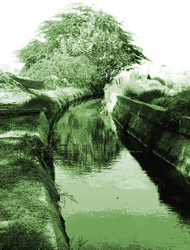
Although its identity remained rooted in agriculture, Al-Kharj’s proximity to Wadi Hanifah and the ancient trade route made it a commercial and political centre as well. Al Kharj has an average elevation of 1,600 feet above sea level, and with the rise of Islam it became a popular, refreshing stop for pilgrims travelling to the Holy Cities from the Gulf. By the 1800s, Al Kharj had become increasingly urbanised and a centre for Islamic scholars.
It is not surprising that during the Second Saudi State in the 19th century, Al Kharj served as a strong centre of support and, later, as a base for the Saud family. After his historic victory in Riyadh, the founder of the modern Kingdom — Abdul Aziz Ibn Abdul Rahman Al Saud — built a palace, complete with a farm and stable, in Al Kharj. The king retreated to it frequently at weekends and during the summer, often bringing guests from Riyadh. The old palace has now been opened as a museum.
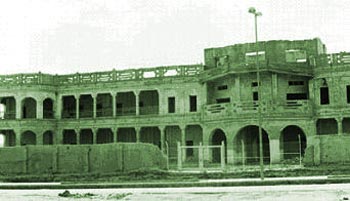
In spite of its many attributes, by the early 1970s the population of Al Kharj was only about 20,000 and little had been done to take advantage of its abundant water supply. Determined to achieve agricultural self-sufficiency, to ensure a supply of water, to encourage rural development and job opportunities for Saudis, and to advance private-sector farming, the Saudi government launched substantial investments in several agricultural regions, including that of Al Kharj.
In the early 1980s, the government offered Saudi farmers free land, and interest-free loans for machinery, fertiliser and seed, and guaranteed the sale of their crops. Al Kharj farmers responded enthusiastically and tapped the natural aquifers, installing centre-pivot irrigation systems that pump over 5,000 litres per minute onto circular plots up to a kilometre in diameter. These round patches of green, seen from the air, have become a distinctive feature of the area.
Today there are 15,000 to 17,000 wells in Al Kharj. Although most are around 200m deep, some probe well over a kilometre into the earth, pumping out water that is close to boiling point, and has to be allowed to cool in ponds before use.
By 1986, hundreds of thousands of tonnes of wheat were being produced at Al Kharj. In addition to bumper crops, grain elevators and a host of small industries, businesses and shops were established to provide products and services to farmers and labourers.
Though the subsidies were set aside a few years ago, more farmers than ever continue to grow crops. The fertile basin supports hundreds of small farms in addition to several large commercial farms. There are also large numbers of farms used as weekend retreats and summer homes by city dwellers in nearby Riyadh.
If farming is difficult to picture in the desert, a booming dairy farm challenges the imagination even more. Yet more than 120,000 head of cattle are raised at Al Kharj (Almarai has the largest dairy farm in the world here), and 80 percent of the dairy products produced in Saudi Arabia come from the area.
The Saudi dairy industry evolved slowly. The Arabian American Oil Company (Aramco) created the first commercial dairy farm in the 1960s. Twenty years later, larger dairies like Almarai were established in Al Kharj, importing Holstein Friesian cattle.
The success of the dairy farming industry has made Saudi Arabia a prime exporter of dairy products in the Middle East. And the abundant supply of dairy cows has triggered a growing beef production programme. Several small farms in the area buy surplus bullocks, fatten them and sell them to Riyadh beef production companies.
The historic centre of Al Kharj still holds many of the traditional mud-brick homes with wooden ceiling beams supporting roofs made of dried palm leaves and mud. Modern buildings now surround the old section, a testament to the recent boom.
Al Kharj’s healthy economy was also boosted by nearby military installations. The large scope of Prince Sultan Air Base, which has some 25,000 personnel, and a military depot have contributed to the housing boom to the north and south of Al Kharj City. The presence of the air base has also triggered new industry, such as a ballistics factory.
In spite of the development it has undergone in the past two decades, the Al Kharj area retains much of its traditional charm. The area’s growth has improved the lives of countless residents. Those who move to urban centres tend to keep a small private farm as a second home where they spend weekends with family and close friends, enjoying the green environment and soothing setting that is characteristic of Al Kharj.
